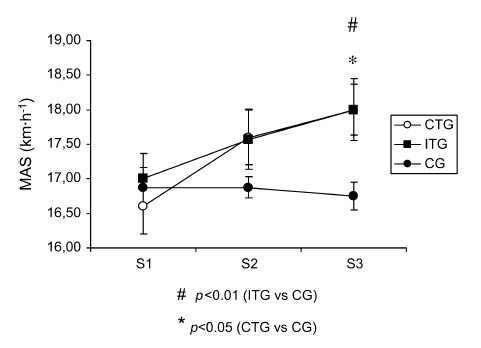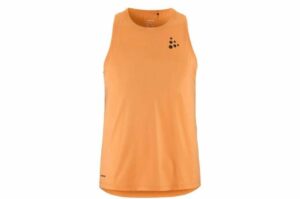Intervals vs. continuous runs
Which type of workout is best? A new study compares the approaches and find they both work.
The age-old debate: which is “better,” interval training or continuous exercise? It’s a stupid debate — but I’ll get to that in a sec. First, a new study in the August issue of the Journal of Strength & Conditioning Research, from researchers in Spain. They put 22 physically active non-runners through one of three different eight-week training programs:
- Intervals: Three workouts a week. Mondays were 4-7 x 2:00, Wednesdays were 3-5 x 3:00, Fridays were 2-5 x 4:00, with rest equal to the length of the interval.
- Continuous: Three workouts a week, starting with 16:00 at 75% of vVO2max and building up to a high of 40:00 at 75% of vVO2max.
- Control: Nuthin’.
Here’s how the three groups progressed (MAS is their speed at VO2max):

As you can see (and as the paper concludes), the interval training and the continuous training produced virtually identical results. Which proves… well… nothing, really. Comparing a steady diet of 100% intervals to a steady diet of 100% continuous runs is like one of those “If you could only bring one album to a desert island to listen to for the rest of your life, what would it be?” conversations. Every different workout provides a slightly different stimulus to the body, so trying to identify “the best” is a pointless exercise. For optimal performance and health, we need a mix of different workouts.
The authors of the new study make an important point when trying to explain why previous comparisons of interval and continuous training have produced mixed results:
[I]t may be suggested that the exercising intensity and the subjects’ training background influence subsequent endurance training adaptations.
This is key! Take someone who has been “jogging” five days a week for a few years and have them start doing hard interval sessions a couple of times a week, and you’ll see dramatic improvements. But if you have someone who has been doing sprint training but no sustained running for a few years, and then add a tempo run and a long run each week, you might see equally dramatic improvements. In neither case does this “prove” that one type of workout is best — it’s context-dependent.
So what’s the perfect mix of workout types? Science doesn’t have an answer, but elite athletes have settled into some consistent patterns through trial and error. A reader (thanks, Marc!) recently sent me a link to an interesting review published a couple of years ago in Sportscience (full text freely available) that analyzes this question very thoroughly based on studies of elite endurance athletes in many different sports. They conclude that there’s an “80:20” rule for intensity:
About 80 % of training sessions are performed completely or predominantly at intensities under the first ventilatory turn point, or a blood-lactate concentration. The remaining ~20 % of sessions are distributed between training at or near the traditional lactate threshold (Zone 2), and training at intensities in the 90-100 %VO2max range, generally as interval training (Zone 3). An elite athlete training 10-12 times per week is therefore likely to dedicate 1-3 sessions weekly to training at intensities at or above the maximum lactate steady state.
Other researchers like Carl Foster break it down into three zones rather than two, and say that athletes do about 70% of their training below threshold, about 20% at or near threshold, and 10% above threshold. That’s a pretty small diet of intervals. Of course, elite athletes have different goals (and more time to train) than the recreationally active volunteers in the Spanish study — so the breakdown of three workouts a week might be quite different from 10-12 workouts a week. Still, my advice for anyone at any level is to include at least one interval session and at least one continuous session in your weekly routine — even if you’re just training twice a week!

